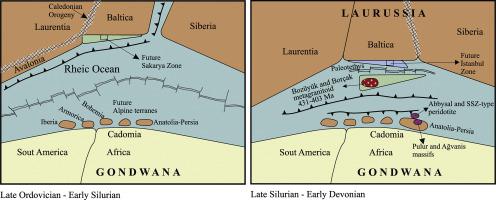Our official English website, www.x-mol.net, welcomes your
feedback! (Note: you will need to create a separate account there.)
Silurian to Early Devonian arc magmatism in the western Sakarya Zone (NW Turkey), with inference to the closure of the Rheic Ocean
Lithos ( IF 2.9 ) Pub Date : 2020-10-01 , DOI: 10.1016/j.lithos.2020.105641 Orhan Karsli , Fırat Şengün , Abdurrahman Dokuz , Raif Kandemir , Faruk Aydin , Tom Andersen
Lithos ( IF 2.9 ) Pub Date : 2020-10-01 , DOI: 10.1016/j.lithos.2020.105641 Orhan Karsli , Fırat Şengün , Abdurrahman Dokuz , Raif Kandemir , Faruk Aydin , Tom Andersen

|
Abstract The Rheic Ocean is the most significant Paleozoic ocean that detached peri-Gondwana terranes from the northern Gondwana margin throughout the closure of the Iapetus Ocean. The suture of the Rheic Ocean spreads from Mexico to the Middle East, and the timing of its final closure is well-documented by the rocks formed in the Variscan-Alleghanian-Ouachita orogeny which led to the formation of the supercontinent Pangaea. However, as robust paleomagnetic and quantitative data are mostly lacking, the onset and evolution of the subduction of the Rheic Ocean are highly speculative, and they require further confirmation. Recently, the well-preserved metagranitoids along the western Sakarya Zone (SZ) in Anatolia have been identified, and they provide new data that improve our knowledge on the evolution of the Early Paleozoic Rheic Ocean along the northern Gondwana. Here, we present new geochronological, in situ zircon Hf isotope, and whole-rock geochemical analyses of these metagranitoids from the western SZ to enhance our understanding of the subduction processes of the Rheic Ocean. LA-ICP-MS zircon U Pb dating demonstrated that the Bozuyuk and Borcak metagranitoids from the western SZ were emplaced during the Silurian to Early Devonian (431 ± 2.7 to 403 ± 3.5 Ma). The both granitoids have medium- to high-K, calc-alkaline magmatic character, and exhibit peraluminous to slightly metaluminous geochemical signature. They showed a typical arc pattern in terms of trace elements and have a uniform, moderate negative eHf (t) of −3.2 to −9.7, with Mesoproterozoic Hf depleted mantle model ages (TDM1 = 1.2 to 1.4 Ga). The geochemical and isotopic characteristics are not consistent with those of depleted mantle melts and melts derived from the crustal rocks in an intracontinental environment. Instead, the parental magma is likely generated from the partial melting of a homogeneous and enriched mantle wedge source. We propose that the Silurian to Early Devonian arc-related magmatism is associated with a northward subduction episode of the Rheic Oceanic lithosphere beneath the peri-Gondwana terranes. Hence, we consider that the opening of Paleotethys Ocean formed in a back-arc basin of subduction in Andean style to the north rather than a continental rift to the south in response to south-directed and short-lived supra-subduction zone (SSZ)-type subduction during the Silurian to Early Devonian.
中文翻译:

西萨卡里亚带(土耳其西北部)志留纪至早泥盆世弧岩浆作用,推断莱茵洋的闭合
摘要 Rheic 洋是最重要的古生代海洋,它在土卫二洋闭合期间从冈瓦纳大陆北部边缘分离了冈瓦纳大陆周围地体。Rheic 洋的缝合线从墨西哥延伸到中东,其最终关闭的时间由 Variscan-Alleghanian-Ouachita 造山运动中形成的岩石充分记录,导致形成超大陆 Pangaea。然而,由于缺乏可靠的古地磁和定量数据,大洋洋俯冲的发生和演化具有高度推测性,需要进一步证实。最近,在安纳托利亚的西萨卡里亚区 (SZ) 发现了保存完好的变花岗岩,它们提供了新的数据,可以提高我们对沿冈瓦纳大陆北部早古生代流变洋演化的认识。在这里,我们提出了新的年代学、原位锆石 Hf 同位素和来自 SZ 西部的这些变花岗岩的全岩地球化学分析,以增强我们对流变洋俯冲过程的理解。LA-ICP-MS锆石U Pb定年表明,西区西部的Bozuyuk和Borcak变花岗岩在志留纪至早泥盆世(431±2.7至403±3.5 Ma)期间就位。这两种花岗岩都具有中至高 K 钙碱性岩浆特征,并表现出过铝质至微铝质地球化学特征。它们在微量元素方面表现出典型的弧形图案,并且具有 -3.2 至 -9.7 的均匀、中等负 eHf (t),与中元古代 Hf 耗尽的地幔模型年龄 (TDM1 = 1.2 至 1.4 Ga)。地球化学和同位素特征与贫化地幔熔体和陆内环境中地壳岩石衍生的熔体的地球化学和同位素特征不一致。相反,母岩浆很可能是由均质富集的地幔楔源部分熔融产生的。我们认为志留纪至早泥盆世的弧相关岩浆活动与冈瓦纳大陆地体下方的莱茵大洋岩石圈向北俯冲事件有关。因此,
更新日期:2020-10-01
中文翻译:

西萨卡里亚带(土耳其西北部)志留纪至早泥盆世弧岩浆作用,推断莱茵洋的闭合
摘要 Rheic 洋是最重要的古生代海洋,它在土卫二洋闭合期间从冈瓦纳大陆北部边缘分离了冈瓦纳大陆周围地体。Rheic 洋的缝合线从墨西哥延伸到中东,其最终关闭的时间由 Variscan-Alleghanian-Ouachita 造山运动中形成的岩石充分记录,导致形成超大陆 Pangaea。然而,由于缺乏可靠的古地磁和定量数据,大洋洋俯冲的发生和演化具有高度推测性,需要进一步证实。最近,在安纳托利亚的西萨卡里亚区 (SZ) 发现了保存完好的变花岗岩,它们提供了新的数据,可以提高我们对沿冈瓦纳大陆北部早古生代流变洋演化的认识。在这里,我们提出了新的年代学、原位锆石 Hf 同位素和来自 SZ 西部的这些变花岗岩的全岩地球化学分析,以增强我们对流变洋俯冲过程的理解。LA-ICP-MS锆石U Pb定年表明,西区西部的Bozuyuk和Borcak变花岗岩在志留纪至早泥盆世(431±2.7至403±3.5 Ma)期间就位。这两种花岗岩都具有中至高 K 钙碱性岩浆特征,并表现出过铝质至微铝质地球化学特征。它们在微量元素方面表现出典型的弧形图案,并且具有 -3.2 至 -9.7 的均匀、中等负 eHf (t),与中元古代 Hf 耗尽的地幔模型年龄 (TDM1 = 1.2 至 1.4 Ga)。地球化学和同位素特征与贫化地幔熔体和陆内环境中地壳岩石衍生的熔体的地球化学和同位素特征不一致。相反,母岩浆很可能是由均质富集的地幔楔源部分熔融产生的。我们认为志留纪至早泥盆世的弧相关岩浆活动与冈瓦纳大陆地体下方的莱茵大洋岩石圈向北俯冲事件有关。因此,











































 京公网安备 11010802027423号
京公网安备 11010802027423号